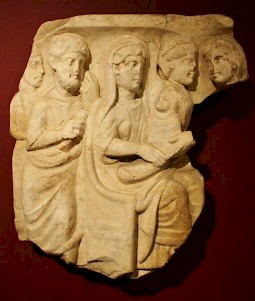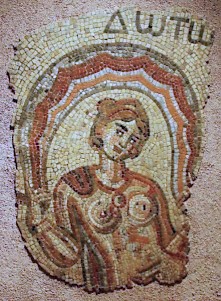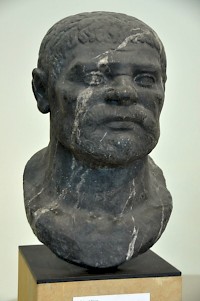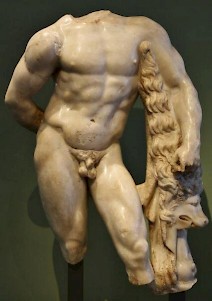Tolosa (Toulouse)
Q60845861Tolosa: (Greek Τολῶσσα): capital of the Volcae Tectosages in southern Gaul, modern Toulouse.
Early History

Tolosa, modern Toulouse in southwestern France, was the capital of the Volscae Tectosages, a Celtic tribe living half-way between the Mediterranean Sea and the Atlantic Ocean. Their city was built on the east bank of the river Garonne, which was from this place navigable, so that it was easy to reach Burdigala (modern Bordeaux). The corridor Narbonne - Toulouse - Bordeaux was one of the main trade routes in preindustrial Europe, which explains the wealth of Tolosa. It could negotiate its own terms when Rome became interested in the region, in 121 BCE, and probably was an ally of Rome first.
In 106, the Volscae Tectosages sided with the Cimbri and Teutones, two Germanic tribes that were roaming through Europe. The Romans, commandend by their consul Q. Servilius Caepio, retaliated and captured the city, finding an incredible amount of money in a sanctuary, which they believed to have been taken away by the Celts who had sacked Delphi in 279 BCE.note Some authors, like Cassius Dio, believe that the gold was indeed from Delphi, and point out that the people who seized it, paid for their sacrilege.note

The Delphian connection, however, was already contested in Antiquity. Posidonius believed that it had been locally produced, pointing at the local mines.note Posidonius also mentions that silver was found, thrown into the lakes. This story is plausible, because in Gaul, it was a common religious practice to deposit precious objects into lakes.
Roman Tolosa
The city now belonged to the province of Narbonensisnote and was given Latin citizen rights by Julius Caesar. The city was fortified by a wall, that was reconstructed in the mid-first century CE.
By this time, the city had come to expand to the west bank of the Garonne, where the Lardenne Plateau lies between this river and the Touch. At a place called Ancely, a religious complex was developed, which included a temple, public baths, seasonal housing, commercial zones, numerous wells, and a swimming pool. Since it was close to the confluence of the Touch and Garonne rivers, the site may have been dedicated to the worship of water, which was, again, a common practice in Roman Gaul.

The amphitheater at nearby Purpan, which is about half a kilometer to the south of the Ancely sanctuary, was probably erected as an annex to the water sanctuary. The outer walls of the amphitheater were made of brick, a product for which Toulouse was famous. Among the Tolosan producers of bricks was a man named Sabinus.
The city appears to have been important as a cultural center as well. The Roman author Suetonius mentions one L.Statius Ursulus of Tolosa, who was "teaching rhetoric in Gaul with great reputation". These words, from his treatise On rhetoricians, are preserved in the the Chronicon of Jerome, who dates this to the years 57-60.note
The emperor Domitian (r.81-96) offered full Roman citizen rights and the rank of colonia to Tolosa, which was by now a very big city. One witness to its size is the fact that it needed two aqueducts. To the already existing sanctuaries, a Capitol was added, a temple dedicated to the Roman triad of Jupiter, Juno, and Minerva. This sanctuary was the scene of the martyrdom of the Christian bishop Saturninus, who was tortured to death during the persecution by the emperor Decius (r. 249-251).

During the reign of Aurelian (r.270-275), the city wall was again rebuilt. It was a sign of the times: Germanic tribes could break through the Rhine frontier and proceed deep into the Roman Empire. In 406/407, the Visigoths sacked the provinces of Aquitaine, Novempopulana, Lugdunensis, and Narbonensis; the Christian author Jerome records that it was only with in his eyes that he could "describe the fate of Tolosa, which was only an admirable action of the holy Bishop Exsuperius guaranteed it was not reduced to ashes".note The poet Rutilius Namatianus also refers to this event.note
The Kingdom of Tolosa
In 418, the Visigoths settled in Tolosa, which became the capital of a new kingdom, with a Roman populace and an elite of Germanic descent. For a fifth-century city, Tolosa flourished. Old buildings continued to be in use and were repaired, sometimes with bricks that had been stripped from the abandoned amphitheater of Purpan.

The Kingdom of Tolosa was loyal to Rome, supported its general Aetius in the war agains the Huns of Atilla (451), and expanded to Spain after the emperor Anthemius had unexpectedly (and unsuccessfully) attacked its ally. When the Franks attacked the Tolosan kingdom, the Visigothic elite retired to their domains in Spain, where the Kingdom of Toledo survived until the arrival of the Islamic armies (711).
Today
The Musée Saint-Raymond is located near the famous Saint-Sernin cathedral. The beautiful collection consists of an overview of the Roman city of Tolosa with a lot of statues and other artefacts, a very rich portrait gallery and a nice collection of tombs and tombstones from the Roman era.